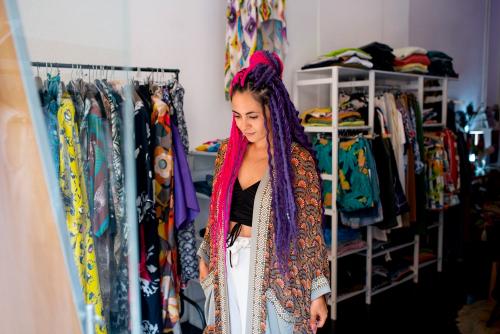Spotting Authentic Vintage Clothing: How to Distinguish Genuine Pieces from Imitations

Vintage clothing holds a special place in the world of fashion. This is because it's not just about style; it's about owning a piece of history. Unfortunately, with the rise in popularity of vintage fashion, the market is flooded with reproductions and imitations.
Let's face it, vintage clothing is everywhere these days. From mega-retailers churning out distressed t-shirts to celebrities rocking recycled looks on the red carpet, everyone wants a piece of the past (sometimes literally).
But here's the thing: sifting through racks for genuine vintage gems can feel like navigating a minefield of fast-fashion fakes. Fear not, fellow fashion foragers! This guide will equip you with the knowledge to separate the authentically awesome from the cheaply copied.
Here are some key tips to guide you in your quest for authentic vintage treasures.
1.
Understand the Era of the Clothing
The first step in
identifying authentic vintage clothing is understanding the era it comes from.
Each era has its distinct styles, fabrics, and construction techniques.
For instance, 1950s dresses often feature cinched waists and full skirts, while the 1970s saw a surge in bohemian styles.
Familiarize
yourself with the fashion trends of different periods. Books, online resources,
and museums can be excellent sources of information.
2.
Examine the Quality and Type of Fabric
Vintage clothing was often made with fabrics that might not be commonly used today. Natural fibers like silk, wool, cotton, and linen were prevalent.
Check the quality of the fabric; older pieces typically have a higher-quality feel. Also, consider the print and pattern – many vintage pieces have unique prints that are hard to replicate accurately.
3.
Look at the Construction and Stitching
The way a garment is made can tell a lot about its age. Vintage clothes were often handmade or tailored, which results in unique and intricate stitching.
Check for irregularities in the stitching – machine-made, uniform stitches are a sign of modern manufacturing. Also, look inside the garment for any signs of alterations, which is common in authentic vintage pieces.
Consulting with a vintage shopping expert can help you
gather insights to help you distinguish genuine vintage pieces from fakes.
4.
Check the Labels and Branding
Older garments usually have labels that look different from modern ones. The style of the logo, the font used, and even the material of the label can provide clues.
Sometimes, you
might find the name of the store instead of the brand, which was a common
practice in earlier decades. Be aware, though, that labels can be reproduced,
so this shouldn’t be your only checkpoint.
5. Pay
Attention to the Fastenings
Zippers, buttons, and other fastenings can be a giveaway. For instance, metal zippers are often found in mid-century clothing, while plastic zippers generally indicate a more recent piece.
Also, the placement
of the zipper can be a clue - side zippers are more common in older garments.
6.
Consider the Overall Style and Cut
The cut of the
garment is a crucial indicator. Fashion silhouettes have evolved significantly
over the decades. For example, a 1960s miniskirt has a distinctly different cut
from a skirt made in the 2000s. Understanding these nuances can greatly help in
identifying genuine vintage.
7.
Seek Expert Opinions
When in doubt,
consult with a vintage shopping expert. In NYC, there are many knowledgeable
dealers and stylists who specialize in vintage fashion. They can provide
valuable insights and help you make informed decisions.
8. Be
Cautious of Too-Good-to-Be-True Deals
If a deal seems too good to be true, it probably is. Authentic vintage pieces, especially from well-known brands or from a notable era, are likely to be priced higher due to their rarity and demand.
Final Words
So, there you have it! With these tips under your belt, you'll be a vintage clothing sleuth in no time. Remember, even the most discerning eye can get fooled. Spotting authentic vintage clothing requires a keen eye and some knowledge of fashion history. Whether you're rummaging through a thrift store in NYC or browsing an online vintage shop, remember these tips to make informed choices.
Authentic vintage pieces are not just garments; they are stories of the past, and owning them is like preserving a piece of history. Happy vintage hunting, and may your wardrobe be filled with threads that whisper fascinating stories, not polyester nightmares pretending to be something they're not!
Post Your Ad Here
Comments